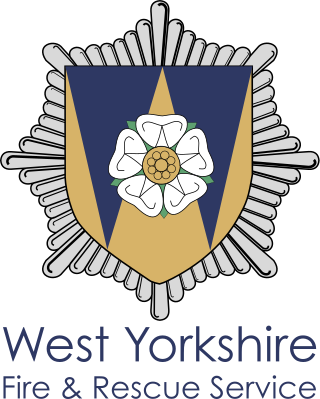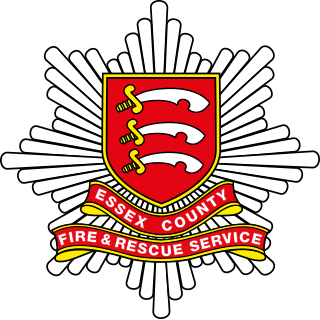
West Midlands Fire Service (WMFS) is the fire and rescue service for the metropolitan county of West Midlands, England. The service is the second largest in England, after London Fire Brigade. The service has 38 fire stations, with a blended fleet of vehicles and specialist resources.

London's Burning is a British television drama programme, produced by London Weekend Television for the ITV network. It was based on the 1986 TV movie of the same name, and focused on the lives of members of the London Fire Brigade, principally those of the Blue Watch, at the fictional Blackwall fire station. It began with the movie (pilot), broadcast on 7 December 1986. This was then followed by a total of 14 series, which ran from 20 February 1988 to 25 August 2002.

The London Fire Brigade (LFB) is the fire and rescue service for London, the capital of the United Kingdom. It was formed by the Metropolitan Fire Brigade Act 1865, under the leadership of superintendent Eyre Massey Shaw. It has 5,992 staff, including 5,096 operational firefighters and officers based at 102 fire stations.
Station officer is a supervisory rank in a number of Commonwealth and other fire services, including those in Australia, the United Kingdom, Ireland, and the New Zealand Fire Service.

For centuries, firefighters have worn helmets to protect them from heat, cinders and falling objects. Although the shape of most fire helmets has changed little over the years, their composition has evolved from traditional leather to metals, to composite helmets constructed of lightweight polymers and other plastics.
Chief fire officer (CFO), formerly often just chief officer, is the highest rank in the fire and rescue services of the United Kingdom. There are currently 50 chief fire officers serving in the United Kingdom in charge of the local authority fire services. There is also a chief fire officer responsible for the Ministry of Defence Fire Services, which includes the Defence Fire and Rescue Service and the RAF Fire Service. Some UK airport fire services also designate their seniors officers as CFOs, though these officers rarely wear the same rank insignia as a local authority chief fire officer.

The fire services in the United Kingdom operate under separate legislative and administrative arrangements in England and Wales, Northern Ireland, and Scotland.
Sub-officer, or the equivalent in other languages, is a term used in many armed forces used to indicate ranks below commissioned officers. Sub-officer is equivalent to the term warrant officer in the British Commonwealth and the United States. Historically armed forces using the term sub-officer have used it to refer to more senior non-commissioned ranks, typically from sergeant upwards, but the term often covers all ranks that other forces designate non-commissioned. In navies the term is comparable to petty officer.
The following outline is provided as an overview of and topical guide to firefighting:

The West Yorkshire Fire & Rescue Service (WYFRS) is the county-wide, statutory emergency fire and rescue service for the metropolitan county of West Yorkshire, England. It is administered by a joint authority of 22 people who are appointed annually from the five metropolitan boroughs of West Yorkshire, known as the Fire & Rescue Authority.

Essex County Fire and Rescue Service (ECFRS) is the statutory fire and rescue service for the county of Essex in the east of England, and is one of the largest fire services in the country, covering an area of 1,338 square miles (3,470 km2) and a population of over 1.7 million people.
The Worsley Hotel Fire was a major arson fire at the Worsley Hotel in Maida Vale, London on 13 December 1974. It killed seven people, including a probationary firefighter.
Ronald James Dobson, CBE, QFSM, FIFireE is a retired senior British firefighter. He was the Chief Fire Officer of the London Fire Brigade until 31 December 2016.
A crew commander or crew manager is a rank within the fire service in the United Kingdom. It is a senior rank to a firefighter, but junior to a watch commander or watch manager.
Firefighting is the act of extinguishing destructive fires. A firefighter fights these fires with the intent to prevent destruction of life, property and the environment. Firefighting is a highly technical profession, which requires years of training and education in order to become proficient. A fire can rapidly spread and endanger many lives; however, with modern firefighting techniques, catastrophe can usually be avoided. To help prevent fires from starting, a firefighter's duties include public education and conducting fire inspections. Because firefighters are often the first responders to victims in critical conditions, firefighters often also provide basic life support as emergency medical technicians or advanced life support as licensed paramedics. Firefighters make up one of the major emergency services, along with the emergency medical service, the police, and many others.
Captain is a rank in various fire services.

The Queensland Fire and Emergency Services (QFES) is the primary provider of fire and emergency services in Queensland, Australia. The QFES was established in 2013, adopting an "all hazards" approach to emergency management.
Stephen Dudeney is a retired British firefighter. He was a senior officer in the London Fire Brigade.







